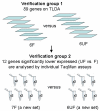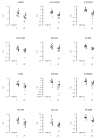Verification of genes differentially expressed in neuroblastoma tumours: a study of potential tumour suppressor genes
- PMID: 19686582
- PMCID: PMC2743704
- DOI: 10.1186/1755-8794-2-53
Verification of genes differentially expressed in neuroblastoma tumours: a study of potential tumour suppressor genes
Abstract
Background: One of the most striking features of the childhood malignancy neuroblastoma (NB) is its clinical heterogeneity. Although there is a great need for better clinical and biological markers to distinguish between tumours with different severity and to improve treatment, no clear-cut prognostic factors have been found. Also, no major NB tumour suppressor genes have been identified.
Methods: In this study we performed expression analysis by quantitative real-time PCR (QPCR) on primary NB tumours divided into two groups, of favourable and unfavourable outcome respectively. Candidate genes were selected on basis of lower expression in unfavourable tumour types compared to favourables in our microarray expression analysis. Selected genes were studied in two steps: (1) using TaqMan Low Density Arrays (TLDA) targeting 89 genes on a set of 12 NB tumour samples, and (2) 12 genes were selected from the TLDA analysis for verification using individual TaqMan assays in a new set of 13 NB tumour samples.
Results: By TLDA analysis, 81 out of 87 genes were found to be significantly differentially expressed between groups, of which 14 have previously been reported as having an altered gene expression in NB. In the second verification round, seven out of 12 transcripts showed significantly lower expression in unfavourable NB tumours, ATBF1, CACNA2D3, CNTNAP2, FUSIP1, GNB1, SLC35E2, and TFAP2B. The gene that showed the highest fold change in the TLDA analysis, POU4F2, was investigated for epigenetic changes (CpG methylation) and mutations in order to explore the cause of the differential expression. Moreover, the fragile site gene CNTNAP2 that showed the largest fold change in verification group 2 was investigated for structural aberrations by copy number analysis. However, the analyses of POU4F2 and CNTNAP2 showed no genetic alterations that could explain a lower expression in unfavourable NB tumours.
Conclusion: Through two steps of verification, seven transcripts were found to significantly discriminate between favourable and unfavourable NB tumours. Four of the transcripts, CACNA2D3, GNB1, SLC35E2, and TFAP2B, have been observed in previous microarray studies, and are in this study independently verified. Our results suggest these transcripts to be markers of malignancy, which could have a potential usefulness in the clinic.
Figures




Similar articles
-
A 6-gene signature identifies four molecular subgroups of neuroblastoma.Cancer Cell Int. 2011 Apr 14;11:9. doi: 10.1186/1475-2867-11-9. Cancer Cell Int. 2011. PMID: 21492432 Free PMC article.
-
Imbalance of the mitochondrial pro- and anti-apoptotic mediators in neuroblastoma tumours with unfavourable biology.Eur J Cancer. 2005 Mar;41(4):635-46. doi: 10.1016/j.ejca.2004.12.021. Eur J Cancer. 2005. PMID: 15737569
-
[New insights into the genetic basis of neuroblastoma].Verh K Acad Geneeskd Belg. 2007;69(4):167-96. Verh K Acad Geneeskd Belg. 2007. PMID: 17821957 Review. Dutch.
-
Expression of the tumour suppressor gene CADM1 is associated with favourable outcome and inhibits cell survival in neuroblastoma.Oncogene. 2008 May 22;27(23):3329-38. doi: 10.1038/sj.onc.1210996. Epub 2007 Dec 17. Oncogene. 2008. PMID: 18084322
-
Evolving significance of prognostic markers associated with new treatment strategies in neuroblastoma.Cancer Lett. 2003 Jul 18;197(1-2):119-24. doi: 10.1016/s0304-3835(03)00094-6. Cancer Lett. 2003. PMID: 12880970 Review.
Cited by
-
A 6-gene signature identifies four molecular subgroups of neuroblastoma.Cancer Cell Int. 2011 Apr 14;11:9. doi: 10.1186/1475-2867-11-9. Cancer Cell Int. 2011. PMID: 21492432 Free PMC article.
-
k-Nearest neighbor models for microarray gene expression analysis and clinical outcome prediction.Pharmacogenomics J. 2010 Aug;10(4):292-309. doi: 10.1038/tpj.2010.56. Pharmacogenomics J. 2010. PMID: 20676068 Free PMC article.
-
Co-expression of transcription factor AP-2beta (TFAP2B) and GATA3 in human mammary epithelial cells with intense, apicobasal immunoreactivity for CK8/18.J Mol Histol. 2021 Dec;52(6):1257-1264. doi: 10.1007/s10735-021-09980-2. Epub 2021 Jun 11. J Mol Histol. 2021. PMID: 34117603 Free PMC article.
-
CACNA2D3 Enhances the Chemosensitivity of Esophageal Squamous Cell Carcinoma to Cisplatin via Inducing Ca2+-Mediated Apoptosis and Suppressing PI3K/Akt Pathways.Front Oncol. 2019 Apr 2;9:185. doi: 10.3389/fonc.2019.00185. eCollection 2019. Front Oncol. 2019. PMID: 31001468 Free PMC article.
-
Functional specialization in nucleotide sugar transporters occurred through differentiation of the gene cluster EamA (DUF6) before the radiation of Viridiplantae.BMC Evol Biol. 2011 May 12;11:123. doi: 10.1186/1471-2148-11-123. BMC Evol Biol. 2011. PMID: 21569384 Free PMC article.
References
-
- Brodeur GM, Pritchard J, Berthold F, Carlsen NL, Castel V, Castelberry RP, De Bernardi B, Evans AE, Favrot M, Hedborg F, et al. Revisions of the international criteria for neuroblastoma diagnosis, staging, and response to treatment. J Clin Oncol. 1993;11:1466–1477. - PubMed
-
- Breslow N, McCann B. Statistical estimation of prognosis for children with neuroblastoma. Cancer Res. 1971;31:2098–2103. - PubMed
LinkOut - more resources
Full Text Sources

